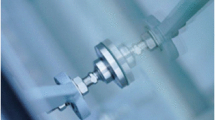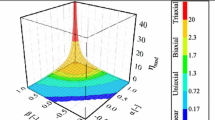Abstract
Uniaxial tension tests were performed on two different thin rubber liner sheets, the silica-filled and the Kevlar-filled EPDM rubber, for the purpose of establishing the constitutive relations via different hyperelasticity models. Due to the fact that the rubber liner sheet can sustain large amount of deformation, over 700 % engineering strain, we used the non-contact, optical technique of digital image correlation to measure local deformation over the sample surface. Three different hyperelastic models were considered for analyzing the experimental measurement, one is the neo-Hookean including the generalized neo-Hookean (GNH), the second is the Rivlin-type models including the special case of Mooney–Rivlin model, and the third is the Ogden model. Model parameters were determined by fitting the hyperelastic model to the experimental data. It was found that the Rivlin model up to the second order and the Ogden model capture the constitutive behavior of both the silica-filled and the Kevlar-filled rubber sheets quite well, while the GNH model can only describe the stress-stretch relation of the Kevlar-filled rubber sheet.













Similar content being viewed by others
References
Chu TC, Ranson WF, Sutton MA, Peters WH (1985) Applications of digital image correlation techniques to experimental mechanics. Exp Mech 25:232–244
Bruck HA, McNeil SR, Sutton MA, Peters WH (1989) Digital image correlation using Newton-Raphson method of partial differential correction. Exp Mech 29:261–267
Vendroux G, Knauss WG (1998) Submicron deformation field measurements: Part 2. Improved digital image correlation. Exp Mech 38:86–92
Sutton MA, McNeill SR, Helm JD, Chao YJ (2000) Advances in two-dimensional and three-dimensional computer vision. Top Appl Phys 77:323–372
Knauss WG, Chasiotis I, Huang Y (2003) Mechanical measurements at the micron and nanometer scales. Mech Mater 35:217–231
Rivlin RS (1947) Torsion of a rubber cylinder. J Appl Phys 18:444–449
Knowles JK (1977) The finite anti-plane shear field near the tip of crack for a class of incompressible elastic solids. Int J Fract 13:611–639
Mooney M (1940) A theory of large elastic deformation. J Appl Phys 11:582–592
Rivlin RS (1948) Large elastic deformations of isotropic materials IV. Further developments of the general theory. Philos Trans R Soc London Ser A 241:379–397
Ogden RW (1972) Large deformation isotropic elasticity. On the correlation of theory and experiment for incompressible rubber-like solids. Philos Trans R Soc London Ser A 326:565–584
Acknowledgments
Los Alamos National Laboratory, an affirmative action equal opportunity employer, is operated by Los Alamos National Security, LLC, for the National Nuclear Security Administration (NNSA) of the U.S. Department of Energy under contract DE-AC52-06NA25396. This study was supported by the Joint DoD/DOE Munitions Program (JMP).
Author information
Authors and Affiliations
Corresponding author
Appendix: Hyperelasticity and hyperelastic constitutive models
Appendix: Hyperelasticity and hyperelastic constitutive models
A brief description of the hyperelasticity theory and several hyperelastic constitutive models is given in this appendix. We also assume that the material considered is incompressible.
Consider a continuum, which in some configuration occupies a closed region \(\mathbb {R}\) in the three-dimensional Euclidean space. A locally volume reserving (incompressible) deformation of the body is characterized by
with
in which \(\varvec{u}\) and \(\varvec{F}\) are the displacement vector field and the deformation gradient tensor field, respectively. We make the assumption that the mapping \(\varvec{y}\) is twice continuously differentiable and uniquely reversible on \(\mathbb {R}\). Next, let \(\varvec{G}\) be the left Cauchy–Green deformation tensor associated with deformation (9) and let \(I_{1}\), \(I_{2}\), and \(I_{3}\) be the scalar invariants of \(\varvec{G},\) where
and
Hyperelasticity assumes that the deforming body possesses an elastic potential \(W(\varvec{x}) = W(\varvec{F}(\varvec{x}),\, \varvec{x})\), such that the first Piola–Kirchhoff (nominal or engineering) stress field associated with the deformation, \(\varvec{\sigma }(\varvec{x})\), is given by
Further, \(\varvec{\sigma }\) is related to the Cauchy (or true) stress field \(\varvec{\tau }\) by
For homogeneous material the elastic potential \(W\) will depend on position \(\varvec{x}\) only through the deformation gradient tensor \(\varvec{F}\), i.e., \(W(\varvec{x}) = W(\varvec{F}(\varvec{x}))\). If we further assume that the material is isotropic in the reference configuration, then the elastic potential is only a function of the scalar invariants \(I_{1}\) and \(I_{2}\). The appropriate constitutive law has the forms
where
and \(p\) represents the arbitrary scalar pressure needed to accommodate the kinematical constraint of incompressibility, and \(\varvec{I}\) is the identity tensor. If \(\uplambda _{i}\) (\(i = 1,\, 2,\, 3\)) are the local principal stretches associated with the deformation, their squares are the local eigenvalues of the tensor field \(\varvec{G}\). As a result,
For uniaxial tension, \(\uplambda _{1} = \uplambda \), \(\uplambda _{2} = \uplambda _{3} = 1/\sqrt{\uplambda },\) where \(\uplambda \) is the axial stretch. Therefore we have
In this investigation, we will study three types of hyperelastic constitutive models. One is the neo-Hookean type [6], including the so-called generalized neo-Hookean [7], the second is the Rivlin type [9], including the so-called Mooney or Mooney–Rivlin model [8], and the third is the Ogden type [10]. The neo-Hookean type models assumes that the elastic potential \(W\) depends on the first scalar invariant only, i.e., \(W = W(I_{1})\). In particular, the neo-Hookean model has the form
where \(c_{1}\) is a constant. The elastic potential function of the generalized neo-Hookean (GNH) model has the form
where \(\mu > 0\), \(b > 0\), and \(n > 1/2\) are constants. Note by setting the exponent \(n = 1\) in the GNH model, the model reduces to the original neo-Hookean model.
The Rivlin-type models assume that the elastic potential function can be written in the form
where \(c_{ij}\) are constants. If we only consider the Rivlin type of model up to the second order, then
where \(c_{i}\) (\(i = 1,\, 2,\, 3,\, 4,\, 5\)) are constants. Note that the above expression includes the neo-Hookean model and the Mooney–Rivlin model, which has the form
as special cases.
The final model that we are considering is the Ogden model, which assumes that the elastic potential function \(W\) depends directly on the local principal stretches \(\uplambda _{i}\) (\(i = 1,\, 2,\, 3\)) through
where \(\alpha _{n}\) and \(\mu _{n}\) are constants. The Ogden model also includes the neo-Hookean model (\(\alpha _{1} = 2\), \(N = 1\)) and the Mooney–Rivlin model (\(\alpha _{1} = 2\), \(\alpha _{2} = -2\), \(N = 2\)) as its special cases.
Rights and permissions
About this article
Cite this article
Liu, C., Cady, C.M., Lovato, M.L. et al. Uniaxial tension of thin rubber liner sheets and hyperelastic model investigation. J Mater Sci 50, 1401–1411 (2015). https://doi.org/10.1007/s10853-014-8700-7
Received:
Accepted:
Published:
Issue Date:
DOI: https://doi.org/10.1007/s10853-014-8700-7




